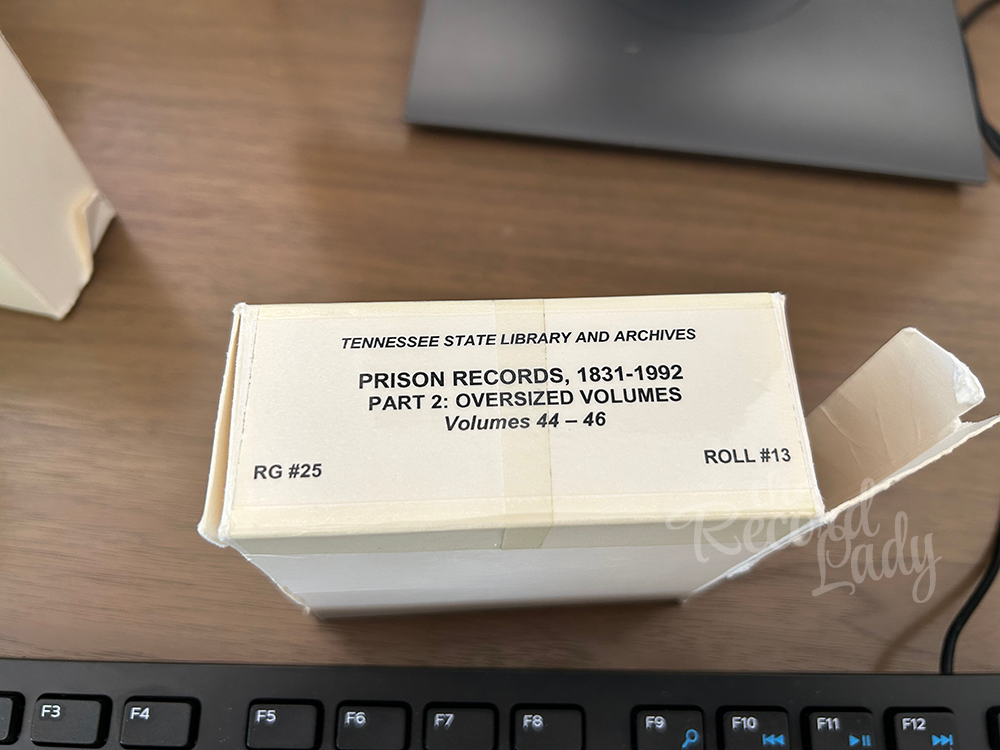I’m particularly drawn to women’s stories because they are so often lost or misplaced in history. When I discovered a Nashville Penitentiary record for “Lucy Witcher,” convicted of barn burning in 1847, I hoped to uncover another forgotten woman’s tale. Instead, what emerged was the story of a man named Lacy Witcher—misidentified as “Lucy” in the prison ledger—whose crime stemmed from a web of grievances, liquor, and revenge in antebellum Tennessee. Though not the woman’s story I initially sought, Lacy’s case offers a fascinating glimpse into 19th-century crime scene investigation, rural justice, and the complexities of a community where personal disputes could literally go up in flames. 1
________
Cornelius “C. C.” Miller’s household bustled with activity on the night of December 27, 1845. His wife Julia had given birth to twins, Frederick and Susan, on the twenty-second.2 Plausibly his wife or a child fell ill because at about eleven that night he sent a boy, possibly an enslaved child, to Dr. Shields.3 The boy later returned to C. C.’s door and recounted he “heard the latch of the gate fall.” C. C. had assumed the boy had gone back to where he slept. Just five minutes later a fire alarm was raised. C. C.’s barn was on fire. Jack—plausibly an enslaved man without a surname—reported he had met a man with a “chunk of fire” on the lane. This news suggested arson rather than an accident.
19th Century Crime Scene Investigation
C. C. Miller sent for his brother-in-law James Forgy and the sheriff Jacob Miller.4 Forgy found the barn burnt and grain smoldering. John Shields (possibly the doctor) joined the men to inspect the damage. In the night they walked about Miller’s field and found footprints in the dust and ashes. They followed a track of ashes and coal for about fifty yards onto McCoy’s place.
At about two that morning, Forgy and Jacob Miller entered Robert McCoy’s house where they found Lacy Witcher. He lay in bed fully dressed except for his shoes and his big coat on the floor. Lacy looked at Forgy and then at Miller as he said, “If I’m going to be hung, I’m going to deny it.”
The following evening Samuel L. Henderson and Francis H. Merchant inspected the scene. They found small coals distributed from the burn site over the fence onto McCoy’s property. They also witnessed the shoe track, noting it was about nine and a half inches with a rounded toe. The track would be measured against Lacy’s shoes. It was a match.
The prosecution proceeded immediately. The sheriff arrested Lacy on 28 December 1845.5 The witnesses made affidavits on the twenty-eighth. Character witnesses gave reasons why Lacy Witcher would want to burn down Miller’s barn. James M. Sizemore said Lacy thought Miller had denied him justice against a Mr. Mees. George Wilhelm said Lacy had been at Sizemore’s stillhouse where Lacy vented and blamed Miller for an unspecified contention between him and Mr. Mees and he was out for revenge.
A Motive?
Perhaps on the night of the fire Robert McCoy stoked Lacy’s grievance with C.C. Miller by ruminating over his own complaints against Miller. In 1843 C. C. sued Robert McCoy in Hawkins County. C.C. prevailed and won a judgment against McCoy.6
Alcohol likely fueled Lacy’s grievance. Further insight into the events that led to the fire came from Robert McCoy. He said he, Lacy, and John Tate met up at his house at sundown, they sent for some liquor, and then engaged in heavy drinking. While McCoy and Tate eventually slept, Lacy continued to drink. McCoy could not say what Lacy had done because he had gone to sleep only to be awakened at two. He found Miller and Forgy in his house and Lacy Witcher in his bed.
McCoy did not help Lacy’s defense—he said he had removed some old oak gate palings7 and disposed of them on the fire. He thought these were the coals found on the way to Miller’s barn. He said Tate had left his house before he went to bed.
Conviction
A grand jury indicted Lacy, saying he acted “not having the fear of God before his eyes, but being moved and seduced by the instigation of the devil.”
On 26 January 1846 Lacy posted an $1000 appearance bond cosigned by Absolom Kyle, James W. Rogan, Morgan O Bryant and George Cox.8
After delays, a jury found Lacy guilty on 27 May 1847.9 Lacy’s attorney immediately made a motion for a new trial. The judge sentenced Lacy on 1 October 1847.10 The Judge asked Lacy if he had anything more to say to which he responded he had nothing further to say than what had already been said. Lacy was sentenced to three years hard labor at the state penitentiary.
Viewing the Nashville Penitentiary Record Book
On my March Genealogy Road Trip I looked at the microfilmed Penitentiary record book at the Tennessee State Library and Archives (TSLA) in Nashville. The ledger book contains information about inmates from their admittance date with notes added upon their eventual release.
Image 1: Tennessee State Library and Archives Microfilm Box, RG #25, Roll #1311

Almost two weeks after conviction, on 12 October 1847 Nashville Penitentiary admitted “Lucy” Witcher of Hawkins County, convicted of barn burning, (see Image 2). He was forty-seven, a laborer, born in North Carolina and he was released on 19 July 1851 (see Image 3). Lacy remained incarcerated in October 1850 and was listed by the census enumerator as “m,” the abbreviation used for males.12 He was pardoned under the act of 1836.13
Images 2 and 3: Nashville Penitentiary, “Lucy Witcher” Entry14
[image 2 right side of book, prisoner no. 956]

[image 3 left side of book, prisoner no. 956]

Epilogue
My goal was to identify the woman Lucy Witcher admitted to Nashville Penitentiary. It became clear this was not a woman (male pronouns were used throughout the court records and he mentioned a wife). His story raises questions that go beyond simply resolving whether the prisoner was named Lucy or Lacy.
The sheriff took steps to look for evidence at the crime scene. Was this a common practice?
Statements mention Lacy’s coat was on the floor. What did that mean?
In 1850 McCoy resided with Sarah, 43; and two teen girls.15 If Sarah was his wife and the girls were his daughters, what did they think about drunk Lacy spending the night? Where were the women sleeping?
Where did Lacy go after release from Nashville Penitentiary? I’ve looked for many of the prisoners after their release and an overwhelming number are not found. I’m betting they changed their names and moved on–into areas of the country where few questions were asked.
Oh, so many questions.

FEATURED IMAGE: “State Penitentiary, Nashville, Tenn.,” postcard, author’s collection.
- Hawkins County, Tennessee, Criminal Court Records, State of Tennessee v. Lacy Witcher, Barn Burning, 27 December 1845; imaged, FamilySearch (https://www.familysearch.org/ark:/61903/3:1:3Q9M-CSY5-Z9XK-F : accessed 7 May 2025) > Image Group Number (IGN) 008371585 > images 1189-1212 of 3227. Wayne Witcher, “Lacy Witcher, Son of Ephraim and Betsey (Fipps) Witcher,” Witcher Family Genealogy (https://witchergeny.com/lacy-witcher%2C-of-ephraim : accessed 7 June 2025). The account of the crime and prosecution are derived from the court records that include C. C. Miller’s statement and witness statements. The court records refer to Lacy Witcher with male pronouns. Lacy Witcher’s family has been written about on the Witcher Family Genealogy website.
- 1850 U.S. census, Hawkins County, Tenn., population schedule, Dist. 9, p. 364-B, dwelling 113, family 113, DeWolf and Susan Miller in C. C. Miller household; imaged, “United States, Census, 1850,” FamilySearch (https://www.familysearch.org/ark:/61903/3:1:S3HT-D83Q-3PT). Find A Grave, database with images (https://www.findagrave.com/memorial/73561003/ : accessed 17 May 2025), “CPT Frederick DeWolf Miller” (1845-1921) memorial created by “Lisa,” with gravestone images created by “Lisa;” citing New Providence Presbyterian Cemetery, Surgoinsville, Hawkins County, Tenn. Find A Grave, database with images (https://www.findagrave.com/memorial/67719188/ : accessed 17 May 2025), “Susan Caroline ‘Sue’ Miller Hoffman,” (1845-1906) memorial created by “Lisa,” with gravestone images created by “Lisa;” citing New Providence Presbyterian Cemetery, Surgoinsville, Hawkins County, Tenn. Frederick and Susan, both aged 4 in 1850, their gravestones show they were both born on 22 December 1845.
- 1850 U.S. census, Hawkins County, Tennessee, population schedule, page 368-A, dwelling 161, family 161, John Shields, a physician; imaged, “United States, Census, 1850,” FamilySearch (https://www.familysearch.org/ark:/61903/3:1:S3HT-D83Q-Q8G).
- History of Tennessee from the Earliest Time to the Present… (Nashville, Tenn.: The Goodspeed Publishing Co., 1887), 880. Reprinted as Goodspeed’s History of Tennessee Containing Historical and Biographical Sketches of Thirty East Tennessee Counties, 1972. Hawkins County, Tenn., Circuit Court Minutes, State v. Lacy Witcher, 28 December 1845; imaged, FamilySearch (https://www.familysearch.org/ark:/61903/3:1:3QHV-D3CD-PZN : accessed 17 May 2025) > Image Group Number (IGN) 008658842 > image 185 of 190. Present Wm Hutcheson, Justice of the Peace; and J. Miller, sheriff.
- Hawkins County, Tenn., Circuit Court Minutes, State v. Lacy Witcher, 28 December 1845.
- Hawkins County, Tennessee, Court Records, loose records, Execution of Judgment, C.C. Miller vs. Robt. McCoy, 5 September 1843; imaged, FamilySearch (https://www.familysearch.org/ark:/61903/3:1:3Q9M-C33H-1316-F) > IGN 008520963 > image 857 of 3162. Jacob Miller signed the document.
- A paling is similar to a wood fence picket
- Hawkins County, Tenn., Circuit Court Minutes, State v. Lacy Witcher, 26 January 1846; imaged, FamilySearch (https://www.familysearch.org/ark:/61903/3:1:3QHV-D3CD-P9TK : accessed 17 May 2025) > IGN 008658845 > image 309 of 403.
- Hawkins County, Tenn., Circuit Court Minutes, State v. Lacy Witcher, 27 May 1847; imaged, FamilySearch (https://www.familysearch.org/ark:/61903/3:1:3QHV-63CD-P9TB : accessed 17 May 2025) > IGN 008658845 > image 335 of 403.
- Hawkins County, Tenn., Circuit Court Minutes, State v. Lacy Witcher, 27 May 1847; imaged, FamilySearch (https://www.familysearch.org/ark:/61903/3:1:3QHV-D3CD-P9PN : accessed 17 May 2025) > IGN 008658845 > image 359 of 403.
- Vanessa Wood, “Tennessee State Library and Archives Microfilm Box, RG #25, Roll #13,” photograph, 2025, Nashville, Tennessee, author’s collection.
- 1850 U.S. census, Davidson County, Tennessee, population schedule, [Nashville Penitentiary], pages 397-B to 310-A, particularly page 398-B, dwelling 587, family 587, Lacy Witchers [sic]; imaged, “United States, Census, 1850,” FamilySearch (https://www.familysearch.org/ark:/61903/3:1:S3HY-6PZZ-FKX).
- State of Tennessee, Public Acts Passed at The First Session of the Twenty-First General Assembly of the State of Tennessee (Nashville, Tennessee: privately published, 1836) 171; repository Tennessee State Library and Archives, Nashville. Chapt. LXIII, Sec. 4 says gave the Governor the right to commute a sentence if a prisoner showed “exemplary and unexceptionable” conduct for “for a whole month.”
- State of Tennessee, Nashville Penitentiary, volume 44, unpaginated, no. 956, “Lucy” Witcher; Tennessee State Library and Archives, “Prison Records, 1831-1992, Part 2: Oversized Volumes, Volumes 44-46,” Record Group #25, microfilm roll #13.
- 1850 U.S. census, Hawkins County, Tennessee, population schedule, District 9, page 363-B, dwelling 92, family 92, Robert McCoy household; imaged, “United States, Census, 1850,” FamilySearch (https://www.familysearch.org/ark:/61903/3:1:S3HT-D83Q-Q39).

